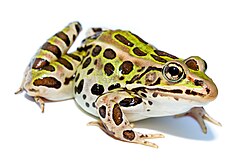Tetrapod
Tetrapod[edit]

Tetrapods are a superclass of animals that includes all vertebrates with four limbs. This group encompasses a wide range of species, including amphibians, reptiles, birds, and mammals. The term "tetrapod" is derived from the Greek words "tetra," meaning four, and "pous," meaning foot.
Evolutionary History[edit]

Tetrapods evolved from lobe-finned fish during the late Devonian period, approximately 360 million years ago. This transition from aquatic to terrestrial life was a significant evolutionary step, allowing vertebrates to exploit new ecological niches on land. The earliest known tetrapods were primarily aquatic, but over time, they adapted to terrestrial environments.
Characteristics[edit]
Tetrapods are characterized by the presence of four limbs, although some species have lost one or more limbs through evolution. For example, snakes and some lizards have evolved to be limbless. Tetrapods typically have a skeleton that supports their body on land, and they possess lungs for breathing air.
Diversity[edit]
Tetrapods are incredibly diverse, with over 30,000 species. They are divided into four major groups:
- Amphibians: This group includes frogs, toads, salamanders, and caecilians. Amphibians are known for their life cycle, which includes an aquatic larval stage and a terrestrial adult stage.
- Reptiles: Reptiles include turtles, crocodilians, lizards, and snakes. They are characterized by their scaly skin and typically lay eggs with leathery shells.
- Birds: Birds are warm-blooded tetrapods with feathers and wings. They are highly adapted for flight, although some species are flightless.
- Mammals: Mammals are warm-blooded tetrapods with hair or fur. They are distinguished by their ability to produce milk to feed their young.
Examples of Tetrapods[edit]

- The Northern leopard frog (Lithobates pipiens) is a common amphibian found in North America.

- The Florida box turtle (Terrapene carolina bauri) is a terrestrial reptile native to the southeastern United States.

- The house sparrow (Passer domesticus) is a small bird commonly found in urban areas worldwide.

- Squirrels are small to medium-sized rodents found in many parts of the world.
Historical Context[edit]

The classification of tetrapods has evolved over time. The Swedish botanist Carl Linnaeus was one of the first to classify animals in a systematic way in his work Systema Naturae (1735). Since then, the understanding of tetrapod relationships has been refined through the study of fossils and genetics.
Related Pages[edit]
Lua error: bad argument #2 to 'title.new' (unrecognized namespace name 'Portal').
Ad. Transform your life with W8MD's Budget GLP-1 injections from $75


W8MD offers a medical weight loss program to lose weight in Philadelphia. Our physician-supervised medical weight loss provides:
- Weight loss injections in NYC (generic and brand names):
- Zepbound / Mounjaro, Wegovy / Ozempic, Saxenda
- Most insurances accepted or discounted self-pay rates. We will obtain insurance prior authorizations if needed.
- Generic GLP1 weight loss injections from $75 for the starting dose.
- Also offer prescription weight loss medications including Phentermine, Qsymia, Diethylpropion, Contrave etc.
NYC weight loss doctor appointmentsNYC weight loss doctor appointments
Start your NYC weight loss journey today at our NYC medical weight loss and Philadelphia medical weight loss clinics.
- Call 718-946-5500 to lose weight in NYC or for medical weight loss in Philadelphia 215-676-2334.
- Tags:NYC medical weight loss, Philadelphia lose weight Zepbound NYC, Budget GLP1 weight loss injections, Wegovy Philadelphia, Wegovy NYC, Philadelphia medical weight loss, Brookly weight loss and Wegovy NYC
|
WikiMD's Wellness Encyclopedia |
| Let Food Be Thy Medicine Medicine Thy Food - Hippocrates |
Medical Disclaimer: WikiMD is not a substitute for professional medical advice. The information on WikiMD is provided as an information resource only, may be incorrect, outdated or misleading, and is not to be used or relied on for any diagnostic or treatment purposes. Please consult your health care provider before making any healthcare decisions or for guidance about a specific medical condition. WikiMD expressly disclaims responsibility, and shall have no liability, for any damages, loss, injury, or liability whatsoever suffered as a result of your reliance on the information contained in this site. By visiting this site you agree to the foregoing terms and conditions, which may from time to time be changed or supplemented by WikiMD. If you do not agree to the foregoing terms and conditions, you should not enter or use this site. See full disclaimer.
Credits:Most images are courtesy of Wikimedia commons, and templates, categories Wikipedia, licensed under CC BY SA or similar.
Translate this page: - East Asian
中文,
日本,
한국어,
South Asian
हिन्दी,
தமிழ்,
తెలుగు,
Urdu,
ಕನ್ನಡ,
Southeast Asian
Indonesian,
Vietnamese,
Thai,
မြန်မာဘာသာ,
বাংলা
European
español,
Deutsch,
français,
Greek,
português do Brasil,
polski,
română,
русский,
Nederlands,
norsk,
svenska,
suomi,
Italian
Middle Eastern & African
عربى,
Turkish,
Persian,
Hebrew,
Afrikaans,
isiZulu,
Kiswahili,
Other
Bulgarian,
Hungarian,
Czech,
Swedish,
മലയാളം,
मराठी,
ਪੰਜਾਬੀ,
ગુજરાતી,
Portuguese,
Ukrainian